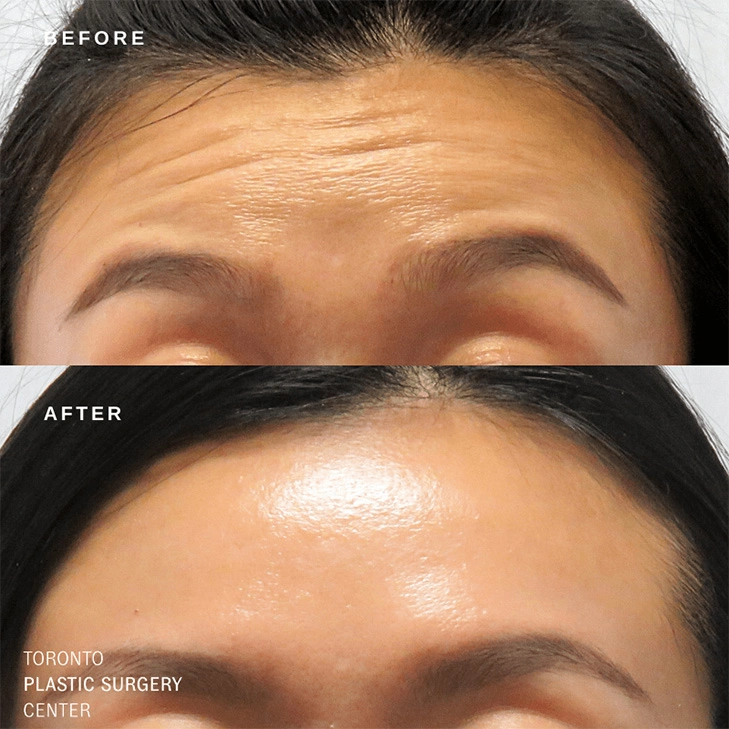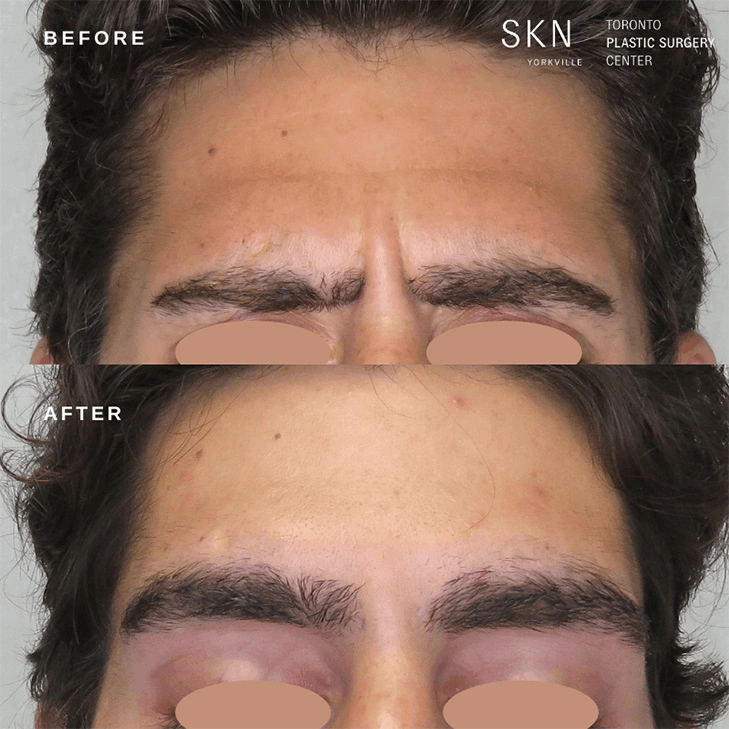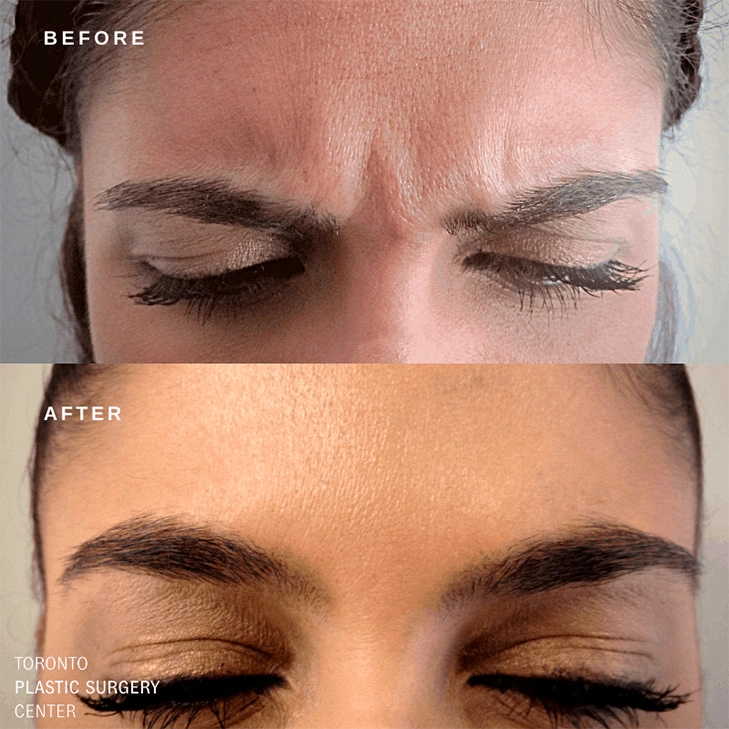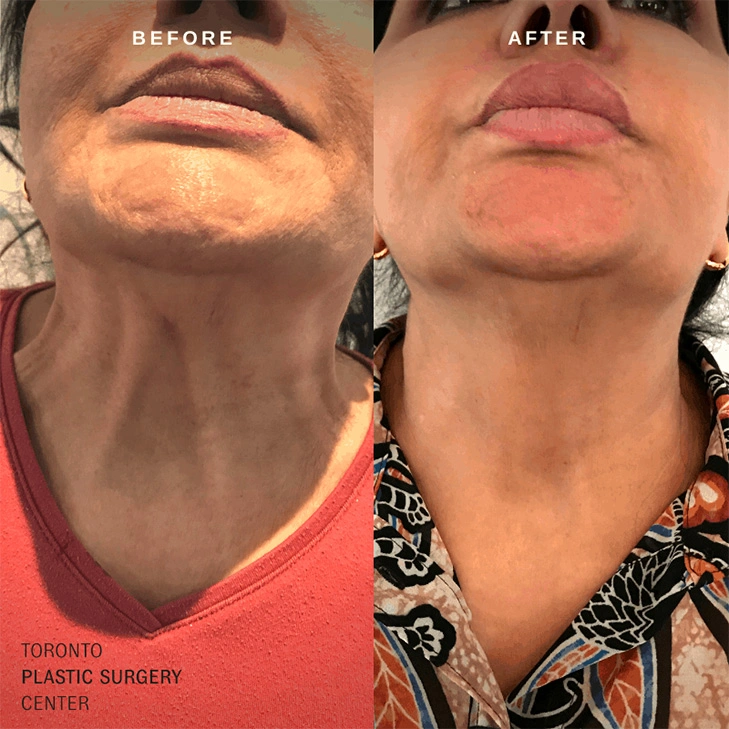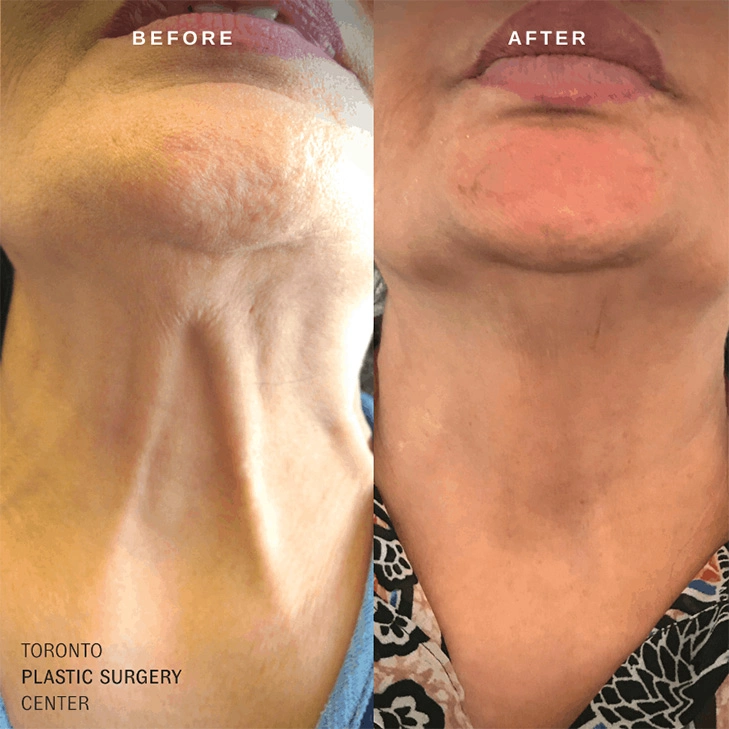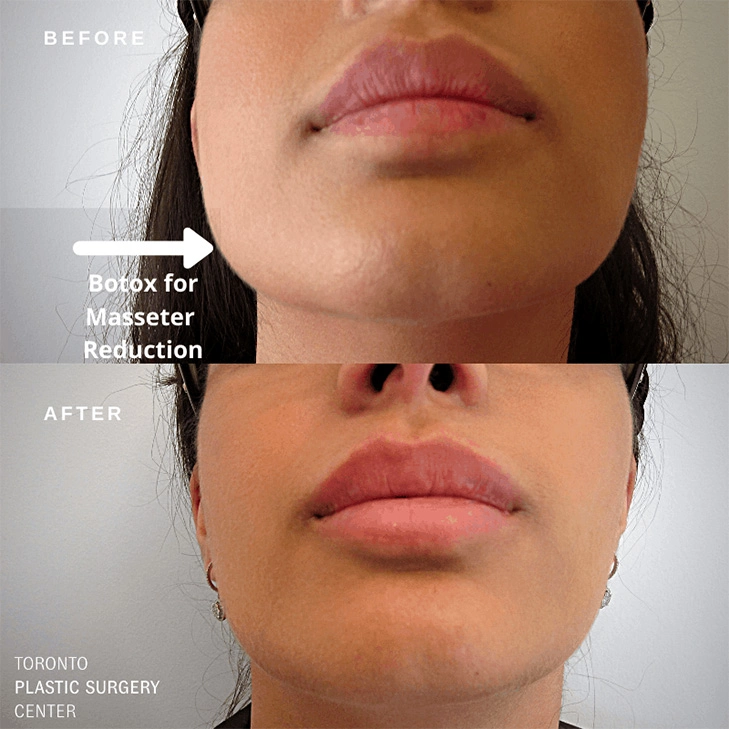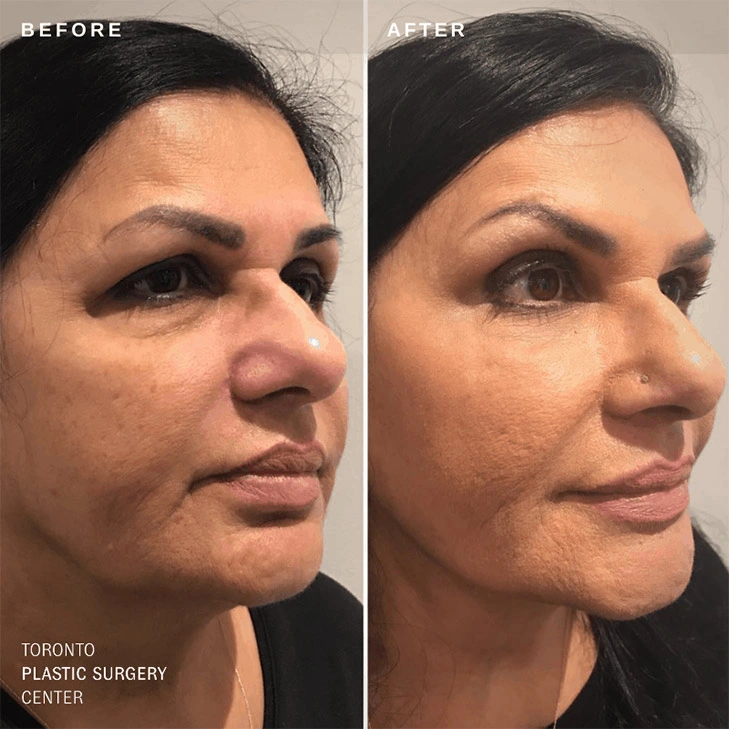NON-SURGICAL PROCEDURES
Smooth
BOTOX®, DYSPORT™, AND NUCEIVA™
$14 Per Unit | $200 Minimum Spend
During the natural aging process, our skin undergoes a number of changes that result in increased lines and wrinkles. As one of Toronto’s most experienced injection specialists, Dr. Pirani uses a combination of products and techniques to soften facial wrinkles and lines, creating a smoother facial profile.
or call (416) 360-8772
NON-SURGICAL PROCEDURES
Smooth
BOTOX®, DYSPORT™, AND NUCEIVA™
$14 Per Unit | $200 Minimum Spend
During the natural aging process, our skin undergoes a number of changes that result in increased lines and wrinkles. As one of Toronto’s most experienced injection specialists, Dr. Pirani uses a combination of products and techniques to soften facial wrinkles and lines, creating a smoother facial profile.
or call (416) 360-8772
Before and After Gallery*
* The results depicted are not guaranteed and may vary between patients.
Botox Cosmetic in Toronto & Dysport Anti-Aging Treatments
We’ll help you reduce the signs of aging with Botox® Cosmetic and Dysport.
Introduction to Botox® Treatment

As one of Toronto’s most experienced BOTOX and Dysport™ injection specialists, Dr. Pirani uses a combination of products and techniques to help with wrinkle reduction. In most cases, these treatments can help create a smoother facial profile by softening facial wrinkles and lines.
What are BOTOX and Dysport™?
BOTOX® and Dysport™ belong to a class of medications known as neuromodulators. They have been used to treat facial wrinkles, excessive sweating (hyperhidrosis), bruxism, and migraines.
These products are two different brands of botulinum toxin A. BOTOX has been in use in Toronto for many years, whereas Dysport™ is a more recent addition to Toronto’s cosmetic market.
How Do BOTOX and Dysport™ Work?
These treatments work by temporarily blocking the signals to muscles causing them to contract. This results in fewer noticeable lines and wrinkles.
BOTOX and Dysport treatments are safe and effective methods approved by the FDA to prevent wrinkle formation.
Botox and Dysport are injected into an individual’s muscles and work by blocking nerve impulses of the treated muscles which leads to the overall reduction of muscle activity in the injected areas. This in turn, leads to the creation of fewer wrinkles, improving your appearance as the fine lines and wrinkles improve, leaving you with a natural, youthful visage.
When botox is personally administered by an experienced professional like Dr. Pirani at the Toronto Plastic Surgery Center, the treatment is highly effective as well as safe.
In What areas of the face can Botox be used?
Botox has been used to provide wrinkle free skin to many areas of the body including the area around your eyes, your eyebrows and your forehead. At the Toronto Plastic Surgery Center, Dr. Pirani is the only practitioner to inject you – we don’t use nurses for Botox injections.
- Forehead: Many facial expressions involve the use of your eyebrows. As a result, horizontal creases naturally form on the forehead. Botox can dramatically improve the appearance of these forehead lines while still maintaining natural movement. Most people require between 10-20 units of Botox in this area.
- Frown Lines: The dreaded 11 Lines or vertical lines that develop between the eyebrows from frowning or concentrating are one of the most common targets of Botox. Dramatic improvements in these lines are typical with Botox. Many patients also experience improvements in headaches from straining these muscles after Botox use. Most people require between 15-30 units of Botox in this area.
- Eyes (Crow’s Feet): The areas around your eyes are sensitive to daily facial movements. Smiling, squinting, and laughing can result in the formation of Crows Feet lines. Botox can help relax the muscles around your eyes to provide a smoother facial profile so that the wrinkles and creases disappear. Most people require between 12-24 units of Botox in this area.
- Eyebrows (Brow Lift): Botox can be strategically injected to create a subtle brow lift effect with higher arched brows. Most people require around 10 units of Botox for this purpose.
- Lips: Lines around the mouth (smoker’s lines) are a difficult problem. Despite the name, they often arise without a smoking history. Improving these lines often requires multiple treatment modalities but Botox is usually the first treatment. Useful adjuncts to improve these lines include radiofrequency microneedling and chemical peels. Some people can also experience a “Lip Lift” with Botox injections to the upper lip. Most people require between 4-8 units of Botox in this area.
- Drooping Corners of the Mouth: If your mouth has a natural downward curve, Botox can help lift the corners of the mouth by relaxing the muscles (DAO muscles) that pull down on the corners of the lips. Most people require between 6-12 units of Botox in this area.
- Chin Dimples: If you are bothered by the dimpling of the skin on your chin then Botox may be of benefit to you. The mentalis muscle creates these dimples when it contracts. By injecting Botox into this muscle and weakening it, the dimples or orange peel appearance of the chin can be dramatically improved. Most people require between 6-10 units of Botox in this area.
- Bunny Lines: The lines that form on your nose when you squint or snarl are called bunny lines. They are caused by contraction of the muscles of your nose (nasalis muscle). These can be improved with Botox. Most people require between 8-16 units of Botox in this area.
- Gummy Smile: Some people are embarrassed by the amount of their gums that are exposed when they smile. This is referred to as a gummy smile. The amount of gum show can be decreased with Botox injections into the muscles that elevate the upper lip (levator labii superioris and levator labii superioris alaeque nasi). Most people require between 4-6 units of Botox in this area.
- Neck Lines (Platysma Bands): As we age the large platysma muscles that reside in our necks begin to descend. These are often seen as prominent vertical bands in the neck. These bands can be weakened and softened with Botox. Most people require between 30-60 units of Botox in this area.
- Masseter Muscles (Wide Jaw): These muscles contribute to the appearance of a wide jaw. They also contribute to bruxism or clenching. Dr. Pirani regularly injects these muscles for both cosmetic narrowing of the jaw, and to improve pain and tension from clenching (bruxism). Some people with TMJ dysfunction also experience improvements in discomfort with weakening of these muscles. Most people require around 50 units of Botox in this area.
- Lower Eyelid: We refer to the small area of fullness under the eyes as the “jelly roll” area. These area of fullness can be improved with a very small amount of Botox. Most people require between 2-4 units of Botox in this area.
- Excessive Sweating (Hyperhidrosis): Excessive sweating can be significantly improved with Botox injections. Typical areas treated include the armpits (axilla), palms, and face (craniofacial). Most people require around 100 units of Botox to treat axillary hyperhidrosis.
- Trapezius Muscles (“TrapTox”): Botox can reduce the size and tension of the trapezius muscles and create a longer and leaner neck and shoulder area. The trapezius muscles are essential for daily movement, but they can become inflamed and enlarged from certain activities, such as weightlifting, reaching overhead, poor sleeping positions and posture, and sitting hunched over. Injecting these muscles with botox can help ease the tension and pain in the neck and shoulder area.
How Long Does It Take To See Results
Even though Botox is a very quick procedure, final results will not be immediately visible post treatment. It takes 2-5 days to begin to see the effects of the Botox treatment in most areas. A slight reduction of wrinkles and facial lines should be noted in these early stages but full effect typically takes 2 weeks for most areas. Areas such as the masseters (jaw) typically take 6 weeks to see the full effects.
Benefits of Botox Injections

When you look good you feel good! Improving your appearance by subtly reducing wrinkles caused by aging and stress can result in a more confident and youthful self. Many patients that have visited our Toronto office tell us that using Botox to reduce their wrinkles results in a boost of confidence, energy, and overall self esteem.
- Simple non-surgical solution to reducing lines: The thought of surgery can be scary. Fortunately, Botox is a non-surgical procedure that is immensely popular. It is often the first step in a facial rejuvenation case that can delay the need for surgical interventions such as a facelift or neck lift.
- Migraine Pain Treatment: Botox can be used to help to reduce migraine pain by relaxing muscles that are causing tension in the head. Dr. Pirani does not offer OHIP Botox treatments.
- Hyperhidrosis Reduction: Excessive sweating can be an embarrassing problem. While prescription anti-perspirants can solve milder cases, people suffering from severe hyperhidrosis can find relief with Botox often experiencing improvements for many months at a time.
- Prostate Gland Reduction: Frequent urination can be a humiliating experience and Botox helps to relieve this problem. When Botox is injected directly into the prostate gland, it improves the flow of urine. Dr. Pirani does not offer this Botox treatment.
Botox Recovery & Results
The beauty of getting a Botox treatment is that you can walk into our office in Toronto on your lunch break, with virtually no downtime after the treatment is over. Results typically begin to appear 2 to 5 days later, with the full benefits being evident after two weeks for most areas.
Even though this is popularly known as a lunch break procedure, you must take caution that you avoid any strenuous activity or exercise for at least 24 hours after your botox treatment. You should also aim to keep your head elevated for a few hours after the treatment. We also recommend that you avoid massaging the injected areas and also avoid taking blood thinning medications which may cause bruising of the skin.
Be sure to follow Dr. Pirani’s after care instructions and ask him about any specific questions you may have about Botox during your consultation with him.
Wrinkle Types Treated with Botox Toronto Cosmetic
Botox is a common and effective treatment for a variety of dynamic wrinkles. Common wrinkles treated with Botox include forehead wrinkles, crow’s feet that form around the outer edge of the eye stretching towards the temple, and frown lines that form at the top of the nose between the eyebrows.
Dynamic Wrinkles
Dynamic wrinkles refer to lines you seen when you move or animate. You do not see them at rest. They form as a result of muscle contraction. As we express ourselves through laughing, crying, smiling or frowning, our facial muscles form these dynamic wrinkles. As muscles contract, the skin over them moves, folds, and stretches, turning into wrinkles and fine lines over time. The repetitive motions our faces make are the cause of these wrinkles, and can be softened and potentially eliminated with the administration of Botox.
Static Wrinkles
Static wrinkles refer to lines that are present even at rest. They represent a progression of dynamic lines over time to creases that are etched into the surface of the skin. Typically, these are more resistant to Botox and require higher doses to treat. They are more likely to require adjunct procedures such as Radiofrequency Microneedling and Chemical Peels in addition to Botox for maximal effect. Botox is still the mainstay initial treatment for these lines, but complete resolution is less likely with Botox alone.
How Many Units Of Botox Do I Need
Assessing the right amount of Botox needed for you can only be determined by your doctor, but a basic understanding of the average units needed for each procedure will help you decide if Botox is for you.
- Forehead: Most people require between 10-20 units of Botox in this area.
- Frown Lines: Most people require between 15-30 units of Botox in this area.
- Eyes (Crow’s Feet): Most people require between 12-24 units of Botox in this area.
- Eyebrows (Brow Lift): Most people require around 10 units of Botox for this purpose.
- Lips: Most people require between 4-8 units of Botox in this area.
- Drooping Corners of the Mouth: Most people require between 6-12 units of Botox in this area.
- Chin Dimples: Most people require between 6-10 units of Botox in this area.
- Bunny Lines: Most people require between 8-16 units of Botox in this area.
- Gummy Smile: Most people require between 4-6 units of Botox in this area.
- Neck Lines (Platysma Bands): Most people require between 30-60 units of Botox in this area.
- Masseter Muscles (Wide Jaw): Most people require around 50 units of Botox in this area.
- Lower Eyelid: Most people require between 2-4 units of Botox in this area.
- Excessive Sweating (Hyperhidrosis): Most people require around 100 units of Botox to treat axillary hyperhidrosis.
- Trapezius Muscles (“TrapTox”): Most people require about 50 units per side with the average person using about 100 units total per session.
All these are basic units needed, but each botox treatment is customized for each individual and your doctor would be the best person to determine the accurate dosage needed for you, depending upon a variety of factors like your gender, treatment area as well as facial muscle strength.
Schedule a consultation with Dr. Pirani at the Toronto Plastic Surgery Center to find out more.
How Much Does Botox Cost
The cost of your Botox treatment is entirely dependent on your individual needs as well as the area that you are having treated. Please note that we charge a minimum of $200+tax for any treatment session.
- Botox is $14 per unit, but the amount of units needed varies.
- The average cost for treating frown lines is between $210 to $420.
- Botox that is performed around the eyes typically costs between $252 and $336.
- Another example is the forehead, which usually requires 10 to 20 units, so can cost between $200 and $280 on average.
The number of units of botox that you require will be determined by Dr. Pirani at your consultation.
Other Medical uses of Botox (Dr. Pirani does not perform these.)
Strabismus: Botox has been proven to be highly effective in dealing with strabismus (also known as crossed eyes). In this treatment, the doctor injects Botox into your eyes to relax the muscles. This causes the eyes to refocus which helps to change the eyes’ position. The procedure has to be repeated every 3-4 months, but the effect lasts longer after multiple treatments.
Muscle Spasms: As Botox is used as a nerve impulse blocker, it is a great solution to muscle spasms, torticollis, cervical dystonia and other movement disorders.
What are the Side Effects of Botox?

When administered by an expert injector, you should have minimal side effects, especially when you follow your doctor’s post treatment advice. If you go with an experienced plastic surgeon like Dr. Pirani at the Toronto Plastic Surgeon Center, you will benefit from his many years of experience. Most people only experience mild swelling, redness and rarely slight bruising in the injected areas. The swelling and redness usually only last a few hours.
Contact Dr. Pirani at the Toronto Plastic Surgery Center if you have any questions or concerns regarding your Botox treatment.
Is Botox Safe?
As Botox is a cosmetic procedure with virtually no permanent effects, it is considered a very safe procedure. As an experienced Botox injector, Dr. Pirani regularly adminsters Botox. He always performs a thorough consultation prior to these treatments and will advise you on your suitability for Botox treatments. He will also ask you about any contraindications to Botox treatments such as pregnancy, keloids, or neuromuscular disorders.
How long do the results from BOTOX and Dysport™ treatments last?
Results usually last approximately 3 to 4 months in most individuals. In some cases such as when used for excessive sweating (hyperhidrosis), results may last up to 6 months.
How are BOTOX and Dysport™ Administered?
BOTOX and Dysport™ are administered via very small injections under the skin. These are usually very well tolerated. Botox treatments usually takes less than 5-10 minutes. The treatment results usually begin to become evident within a few days; however, it takes a full 2 weeks to see the final results.
Dr. Pirani Will Administer Botox Injections
When it comes to your health and well being, you don’t expect second best. One of the things that sets Dr. Pirani apart from other plastic surgeons is that he doesn’t use nurses to administer Botox treatments to his patients. When you come to Dr. Pirani for your Botox treatments, you get Dr. Pirani. He has years of experience behind him and his personal care and attention to detail are the primary reasons people choose him as their preferred Botox injector.
Things You Should Not Do Right After Botox Treatment
As non-invasive as Botox is, it can be easy to over-do certain actions following a Botox procedure. To receive the best results possible, it is important that you avoid these things after your treatment.
- Exercise: Once injected, Botox needs to settle in your body for 24 hours before you work-out. This also includes any strenuous physical activity. Just take it easy.
- Rubbing the injection sites: Receiving injections will naturally make you want to rub or massage the injection areas. You need to avoid this to prevent moving the Botox to other areas as this can result in unwanted effects.
- Consuming alcohol: Drinking alcohol after your Botox procedure could cause you to bruise where you wouldn’t have otherwise. You should also avoid alcohol for a few days before your treatment.
- Sleeping on your face: This might be a challenge for people who sleep on their stomach, but you need to avoid doing that right after a procedure. Even if you are just taking a simple nap, pressure on your injection sites can cause the Botox to shift out of place.
- Heat exposure: Due to the redness and swelling that can accompany Botox, you will need to keep yourself in the shade until the swelling goes away. Avoid all sunbathing activities.
- Blood thinners: Do not take blood thinners following your procedure or right before it. This is to prevent excess bleeding or bruising at the injection sites.
It is important that you follow all of Dr. Pirani’s aftercare instructions in order to have the best results possible.
Who is a Good Candidate for BOTOX and Dysport™ Treatments?
If you’ve noticed any of the following, then you may be an excellent candidate for BOTOX or Dysport™ treatments:
• Vertical lines between your eyebrows (Frown lines)
• Horizontal lines in your forehead (Forehead wrinkles)
• Lines and wrinkles around your eyes (Crow’s Feet)
• A drooping eyebrow or poor eyebrow shape
• Wrinkles and lines around your lips (Marionette lines and Smoker’s Lines)
• Horizontal lines on your nose (Bunny Lines)
• Horizontal lines above your chin
• A widened jaw (often common in Asians and patients with bruxism)
• Hyperhidrosis or excess sweating in your armpits or palms
• Prominent bands in your neck
Is there a Difference between BOTOX and Dysport™?

Botox Vs. Dysport™?
There has been much debate regarding the differences between the two products or if there is even much of a difference at all. However, here are the main differences between the products:
• Dysport™ may not last as long (duration of efficacy). This is still being debated and studied however.
• Dysport™ has a slightly quicker onset (2-5 days vs. 4-7 days for Botox)
• Dysport™ diffuses more. This may be an advantage in some areas of the face and a disadvantage in other areas.
Generally, the injection technique and dosing is more important than what product is used. Poor results are more commonly technique or dose related and less commonly due to which product is used. Dr. Pirani carries and used Botox, Dysport, and Nuceiva (Jeuveau). He typically prefers to use Botox and Nuceiva in most areas and uses them interchangeably.
Who Should Not Use BOTOX and Dysport™?
You should avoid treatments if:
• You are allergic or sensitive to any of the ingredients
• You are allergic to cow’s milk protein (only an issue with Dysport™)
• You have myasthenia gravis, Eaton Lambert Syndrome, amyotrophic lateral sclerosis or another muscle disorder
• You are allergic or sensitive to any botulinum toxin product
• You have an infection at the proposed injection site
• You are taking aminoglycoside antibiotics
• You are pregnant
• You are nursing
What Can I do to Prepare for my BOTOX and Dysport™ treatments?
You should avoid using any non-essential medication or herbal remedy that may increase your chance of bruising for 2 weeks before your BOTOX or Dysport™ treatment session. This includes:
- Aspirin (only stop this if your family physician indicates it is safe to do so)
- Advil or Motrin
- Omegas
- Fish oils
- Vitamin E
- Garlic
- Glucosamine
- Ginseng
- Ginko biloba
- Saw palmetto
What should I do after my BOTOX and Dysport™ treatments?
After receiving your BOTOX and Dysport™ treatments it is important to avoid any strenuous activities for at least 24 hours. This helps avoid bruising. It is also a good idea to avoid any activities that cause your head to be in a dependent position for 24 hours after your treatments.
Will the injections hurt?
Some patients report that being injected by either of the products feels like a pinch. Dr. Pirani may use ice to numb the treatment area. If you are concerned about discomfort, he may also apply a topical numbing cream before administering your treatment.
How long does treatment take
Initially, Dr. Pirani will discuss your treatment goals and perform a facial analysis to determine optimal treatment for you. However, the actual injection process only takes around 10 minutes.
Botox Consultation
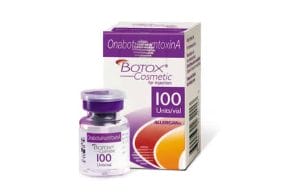
During the initial consultation, Dr. Pirani will discuss your concerns and goals with you. He will then assess your facial lines, musculature, and proportions to determine the best treatment options for you. This will include a discussion of risks, benefits, and potential complications. He will also give you an idea of what you should expect in terms of results and recovery.
Although this initial consultation is quite thorough, the following treatment sessions can take as little as 5 minutes. Many patients come in for treatments during their lunch breaks to maximize efficiency. Dr. Pirani and the Toronto Plastic Surgery Center Team will do everything they can to accommodate your time constraints and busy schedule.
To schedule a consultation with Toronto BOTOX and Dysport™ treatment specialist, Dr. Pirani, call 416-360-8772.
8 Things You Should Not To Do Right After Botox Treatment

Once you’ve decided to receive a Botox treatment, it is important to take proper care of yourself after in order to receive the best results. While the process varies depending on the area you’ve received treatment, and your particular body, there are eight things that are very important to avoid following treatment in order to ensure you receive the best possible results.
1. Touching: It is vital to avoid touching the area you received your Botox in the 24 hours following your treatment. A Botox injection is precisely administered to achieve the desired effects, and touching could result in it moving to unintended muscles.
2. Alcohol and Painkillers: Certain drugs, such as aspirin, along with alcohol should be avoided as they can cause your blood to thin and cause excess bleeding. Depending on how quickly you recover, aspirin and alcohol are recommended to be avoided for 48 hours following treatment.
3. Careless Sleeping: It is recommended to avoid the horizontal position for about four hours following your Botox injection to allow the treatment to properly settle within your body and to look how your provider intended it to look. Not only this, when you go to sleep in the immediate days following your treatment, try to sleep on your back to have the best possible results.
4. Exercise: There are few times when a doctor will advise against an active lifestyle, but following a Botox treatment, it is important to avoid any strenuous activity. You should be able to return to your regular exercise regimen usually after a couple days, but some people take it easy for up to a week after Botox.
5. Facials: Facials, along with chemical peels and other face treatments can interfere with your Botox injection, causing it to end up with undesirable results. Plan to do these treatments at least 24 hours after receiving a Botox injection.
6. Travel: It is important to stay in touch with and within reach of your doctor following a Botox treatment. That way, in the event that you experience any unexpected side effects, you’ll be able to visit the doctor who administered the treatment to help remedy any issue.
7. Schedule Photos: While you may be excited by your rejuvenated appearance following a Botox treatment, some people experience bruising which can take 1-2 weeks to resolve, depending on the individual. So, give it a week or two to make sure that you’re looking your very best.
8. Settling: If you aren’t happy with your results, talk to Dr. Pirani about what may have happened or what you would prefer. We want to make sure every patient has a treatment that they are proud of and are happy with the way they look. If you don’t like what you see, talk to us so we can help you look and feel your best.



